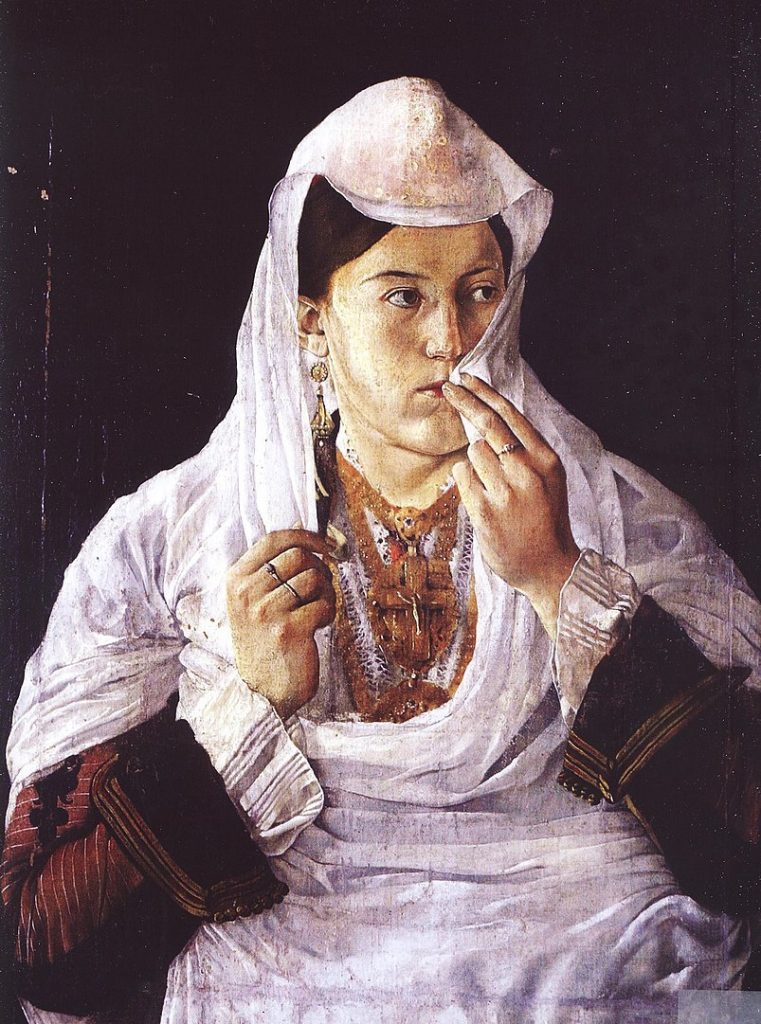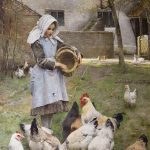
Albanian art has a rich history that spans centuries, showcasing the talents of artists who have made significant contributions to the cultural and artistic heritage of the country. From the detailed religious icons of the Renaissance period to the expressive modern works of the 20th century, Albanian artists have continually pushed the boundaries of creativity and storytelling. This list highlights some of the most influential figures in Albanian art, offering a glimpse into their unique styles and the lasting impact they have left on the art world.
Sadri Ahmeti (1939–2010) – Ahmeti was known for his paintings that reflected rural Albanian life and landscapes. His works often captured the simplicity and charm of village life in Albania. Ahmeti’s art was characterized by warm, earthy tones and a focus on pastoral scenes, which made his work widely appreciated.
Andrea Aleksi (1425–1505) – A prominent Renaissance sculptor and architect, Aleksi was known for his intricate religious sculptures. He contributed to the construction of several churches in the Balkans. Aleksi’s skill in stone carving set a high standard for religious art in Albania during his time.
Mustafa Arapi (born 1950) – Arapi is an Albanian painter known for his abstract works. His art often explores themes of spirituality and the human condition. Arapi has exhibited his work both locally and internationally, earning recognition for his unique style and thought-provoking pieces.
Marco Basaiti (1470–1530) – A Venetian-Albanian painter, Basaiti was known for his religious compositions in the High Renaissance style. His works include detailed altarpieces with expressive figures. Basaiti was a contemporary of Giovanni Bellini, and his style reflects the influence of Venetian Renaissance art.
Engjëll Berisha (1926–2010) – Berisha was known for his landscapes and portraits. His works are characterized by a deep appreciation for nature and vibrant colors. Berisha’s art often featured themes of peace, tranquility, and Albanian heritage.
Lumturi Blloshmi (1944–2020) – Blloshmi was a contemporary artist known for her experimental approach to painting. She often explored themes of femininity and identity in her work. Blloshmi’s art was recognized for its use of bold colors and abstract forms, making her one of Albania’s most innovative artists.
Abdurrahim Buza (1905–1987) – Buza was one of the most influential Albanian painters of the 20th century. His works often depicted everyday life in Albania, with a focus on realism. Buza’s style was characterized by attention to detail and a deep sense of national pride.
Masar Caka (1946–2000) – Caka was known for his expressive and colorful paintings. He was one of the notable artists in post-World War II Albania. Caka’s art often conveyed a sense of energy and emotion, reflecting the dynamic spirit of the Albanian people.
Tahir Emra (1938–2024) – Emra is celebrated for his work in portraiture and landscapes. His style blends realism with a touch of impressionism. Emra’s paintings often captured the essence of Albanian culture and tradition, making him a beloved figure in the art community.
Fatmir Haxhiu (1927–2001) – Haxhiu was known for his socially conscious artworks that often focused on the working class. His paintings frequently conveyed messages about social issues and national pride. Haxhiu’s use of strong, bold colors and realistic compositions made his work visually striking and impactful.
Ervin Hatibi (born 1974) – Hatibi is a versatile Albanian artist known for his poetry and visual art. His paintings often feature elements of surrealism and symbolism. Hatibi is celebrated for his ability to combine literature and visual art, creating a rich, multi-layered artistic experience.
Kolë Idromeno (1860–1939) – Idromeno was a pioneering Albanian artist known for his work in painting, architecture, and photography. His most famous painting, “The Wedding,” is celebrated for its realistic depiction of Albanian culture. Idromeno’s diverse talents made him a key figure in the development of modern Albanian art.
Ilir Jaçellari (born 1970) – Jaçellari is a contemporary Albanian artist known for his figurative and abstract paintings. His works often explore themes of human connection and introspection. Jaçellari’s art has been exhibited in numerous galleries, earning him recognition in the international art community.
Agim Kadillari (born 1953) – Kadillari is known for his intricate and expressive paintings. His works often focus on nature, people, and cultural heritage. Kadillari’s style blends realism with a touch of abstraction, creating visually engaging compositions.
Sadik Kaceli (1912–2000) – Kaceli was a prominent Albanian painter known for his figurative and portrait art. He played a key role in the development of modern art in Albania. Kaceli’s work often depicted Albanian history and culture with a sense of dignity and pride.
Ibrahim Kodra (1918–2006) – Kodra was one of the most famous Albanian painters of the 20th century. He was known for his abstract, Cubist-inspired style. Kodra’s work gained international recognition, and he is often referred to as an ambassador of Albanian art.
Zef Kolombi (1907–1949) – Kolombi was known for his portraits, still lifes, and landscapes. His works were characterized by a sense of warmth and realism. Kolombi’s art captured the spirit of everyday Albanian life with great sensitivity and detail.
Omer Kaleshi (1932–2022) – Kaleshi was a renowned painter known for his expressive portraits. His works often featured strong, dramatic brushstrokes and vibrant colors. Kaleshi’s art explored themes of identity, humanity, and the Albanian experience.
Andrea Kushi (1884–1959) – Kushi was a painter known for his portraits and historical scenes. His works are characterized by their realism and attention to detail. Kushi’s art often depicted Albanian figures and stories, celebrating the nation’s heritage.
Gazmend Leka (born 1953) – Leka is an Albanian painter known for his figurative and abstract works. His art often explores themes of human emotion and existentialism. Leka’s use of color and form creates a sense of depth and introspection in his pieces.
Nimon Lokaj (born 1941) – Lokaj is known for his landscape paintings and depictions of traditional Albanian life. His art often captures the beauty of the Albanian countryside. Lokaj’s work is celebrated for its harmonious compositions and vibrant color palette.
Ndoc Martini (1880–1916) – Martini was one of the early Albanian impressionist painters. His work often depicted landscapes, still lifes, and portraits. Martini’s art is known for its use of light and color, capturing the essence of the scenes he painted.
Agathangjel Mbrica (1883–1957) – Mbrica was known for his religious paintings and murals. His art often adorned churches in Albania, reflecting his strong connection to faith. Mbrica’s detailed and expressive style made his work highly respected.
Vangjush Mio (1891–1957) – Mio is often regarded as one of Albania’s greatest landscape painters. His works captured the beauty of Albanian nature and architecture. Mio’s art was characterized by its use of light, creating a sense of atmosphere and tranquility.
Muslim Mulliqi (1934–1998) – Mulliqi was known for his abstract paintings that often conveyed deep emotion. His work was influenced by European modernist movements. Mulliqi’s bold use of color and dynamic compositions made him a standout figure in Albanian art.
Fatmir Musaj (born 1958) – Musaj is known for his contemporary paintings that often feature abstract elements. His works explore themes of human nature and identity. Musaj’s art has been exhibited in several international galleries.
Nasuf Myftari (born 1958) – Myftari is known for his figurative art, often focusing on Albanian culture and history. His paintings are characterized by a strong sense of narrative and composition. Myftari’s work has been well-received both locally and internationally.
Onufri (16th Century) – Onufri was one of Albania’s most celebrated icon painters. He was known for his distinctive use of red in religious icons. Onufri’s work is considered a cornerstone of Albanian medieval art, and he is remembered for his innovative approach to color and form.
George Pali (born 1957) – Pali is a contemporary Albanian painter known for his abstract works. His art often explores themes of movement and transformation. Pali’s dynamic brushwork and vibrant colors create a sense of energy in his compositions.
Edi Rama (born 1964) – Rama is a multidisciplinary artist known for his abstract drawings and installations. In addition to being an artist, he is also a prominent political figure, serving as the Prime Minister of Albania. Rama’s art often explores themes of chaos and order.
Ramadan Ramadani (1944–2005) – Ramadani was known for his expressive portraits and figure studies. His works often conveyed a deep sense of emotion. Ramadani’s art was characterized by its realism and attention to the human form.
Chatin Sarachi (1899–1974) – Sarachi was known for his paintings and drawings that often depicted scenes of everyday life. His works reflected a deep appreciation for Albanian culture. Sarachi’s art was noted for its use of line and composition.
David Selenica (18th Century) – Selenica was a prominent icon painter known for his religious frescoes. His works often adorned churches in Albania and the surrounding regions. Selenica’s style was known for its detail and expressive use of color.
Zef Shoshi (born 1939) – Shoshi is known for his realistic paintings and portraits. His works often capture the essence of Albanian people and landscapes. Shoshi’s art has been praised for its technical skill and emotional depth.
Saimir Strati (born 1966) – Strati is known for his mosaic art, often created from unconventional materials. He holds several Guinness World Records for his large-scale mosaics. Strati’s works are celebrated for their creativity and craftsmanship.
Arthur Tashko (1901–1994) – Tashko was known for his portraits and still lifes. His works were characterized by their technical precision. Tashko’s art often reflected themes of Albanian heritage and tradition.
Spiro Xega (1861–1953) – Xega was known for his landscape paintings and depictions of rural life. His works often conveyed a deep sense of connection to the land. Xega’s art was celebrated for its use of light and naturalistic approach.
Eltjon Valle (born 1984) – Valle is a contemporary artist known for his installations and multimedia art. His works often explore themes of urbanization and cultural identity. Valle’s art has been exhibited in various international exhibitions.
Esat Valla (born 1944) – Valla is known for his abstract and expressionist paintings. His works often convey a sense of movement and energy. Valla’s bold use of color and texture makes his art visually impactful.
Maks Velo (1935–2020) – Velo was a painter, architect, and writer known for his avant-garde style. His works often challenged the conventions of Albanian art. Velo’s art was noted for its innovative use of form and concept.
Agim Zajmi (1936–2013) – Zajmi was a prominent Albanian painter and scenographer. His works often focused on theatrical themes. Zajmi’s art was known for its dramatic compositions and attention to storytelling.
Nexhmedin Zajmi (1916–1991) – Zajmi was known for his work in painting and set design. His art often depicted Albanian life and history. Zajmi’s style was characterized by its sense of movement and use of light.
Zografi Brothers (18th Century) – The Zografi Brothers were known for their religious frescoes and icons. Their work can be found in churches throughout Albania and Greece. The brothers’ detailed and expressive style made them key figures in Albanian ecclesiastical art.
The journey through Albanian art reveals a legacy of passion, creativity, and resilience. These artists have captured the essence of their times, using their work to tell stories, evoke emotions, and celebrate their culture. By honoring these artists, we acknowledge the importance of preserving and sharing Albania’s rich artistic heritage, ensuring that it continues to inspire future generations of art lovers and creators.




